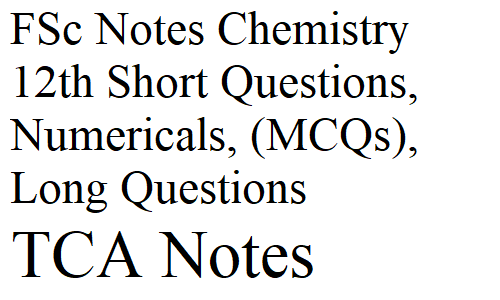FSc Notes Chemistry 12th
2nd year Chemistry Notes, Short Questions, Numericals, Multiple Choice Questions (MCQs), Long Questions
| Chapter Name | Ex MCQs & Extra MCQs | Ex Questions & Extra SQs | |
| Ch 1 Periodic Classification of Elements and Periodicity | MCQs | Ex Questions | |
| Ch 2 S-Block Elements | MCQs | Ex Questions | |
| Ch 3 Group IIIA and Group IVA Elements | MCQs | Ex Questions | |
| Ch 4 Group VA and Group VIA Elements | MCQs | Ex Questions | |
| Ch 5 The Halogens and The Noble Gases | MCQs | Ex Questions | |
| Ch 6 Transition Elements | MCQs | Ex Questions | |
| Ch 7 Fundamental Principles of Organic Chemistry | MCQs | Ex Questions | |
| Ch 8 Aliphatic Hydrocarbons | MCQs | Ex Questions | |
| Ch 9 Aromatic Hydrocarbons | MCQs | Ex Questions | |
| Ch 10 Alkyl Halides | MCQs | Ex Questions | |
| Ch 11 Alcohols, Phenols and Ethers | MCQs | Ex Questions | |
| Ch 12 Aldehydes and Ketones | MCQs | Ex Questions | |
| Ch 13 Carboxylic Acids | MCQs | Ex Questions | |
| Ch 14 Macromolecules | MCQs | Ex Questions | |
| Ch 15 Common Chemical Industries in Pakistan | MCQs | Ex Questions | |
| Ch 16 Environmental Chemistry | MCQs | Ex Questions |
All MCQs of Chemistry 12th are given below. If you want to review questions you can do so by clicking the above links.
Category: Chemistry 12th Ex
Chemistry 12th Ch 1-16 Ex
Category: Chemistry 12th Additional
Chemistry 12th Ch 1-16 Additional

